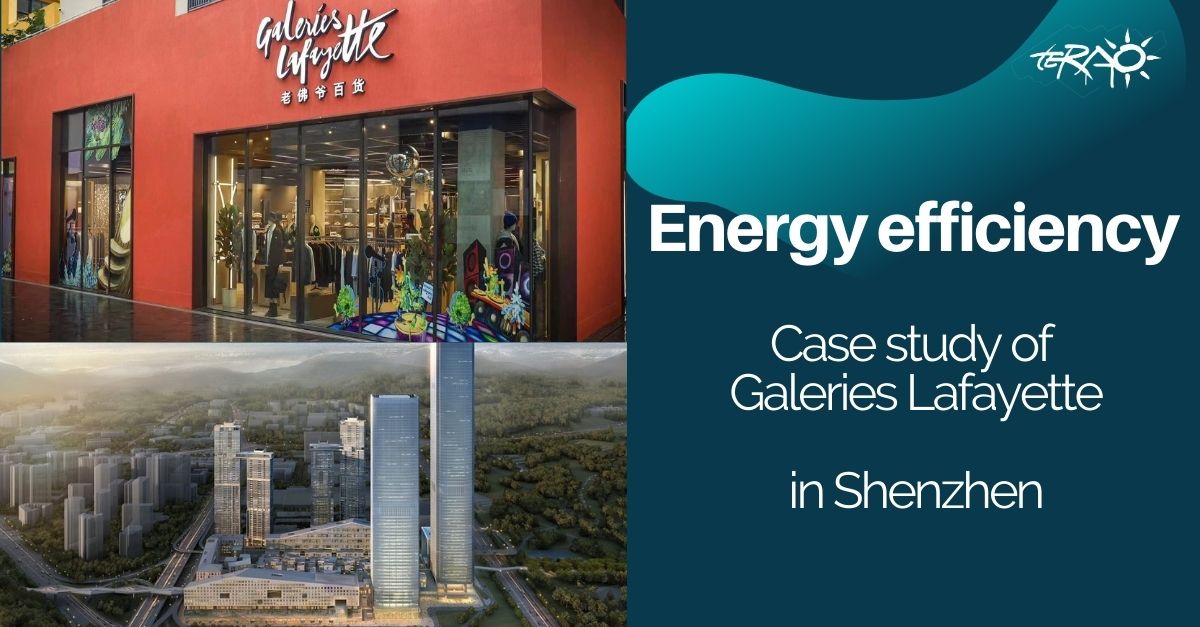In early 2023, Galeries Lafayette will open a store in Shenzhen’s city Futian district, as part of its development in China.
Galeries Lafayette wanted to estimate the detailed energy consumption of this mall, before its construction. An Energy estimation study could help Galeries Lafayette gain a clear understanding of the behavior of the store and then identify future relevant optimization strategies.
That is what TERAO has been missioned by Archetype company to carry out, and we will explain below how our results have been obtained for this project.
Method
There are several steps to assist our client in achieving their target. TERAO team initially gathers pertinent data from Archetype project team and then performs a focused analysis.
First, building location. To understand how the environment around the building affects it, we must know the location. The issue of ambient temperature and daylight conditions influencing building energy use is a particular concern for this project.
Second, building envelope. The determination of the building envelope includes wall, floor, and glazing specifications. These elements have a direct influence on energy consumption.

The next factor to determine is occupancy. The number of people will generate a specific amount of heat in the building. Therefore, knowing how many people frequent the building will enable more precise estimations.
Then, collecting information on the current HVAC system configuration, and the number of air conditioners used in the building with high or low efficiency. In addition, we should determine the set points in the area as well as the working schedule.
Lighting specification for interior, and exterior applications and working schedule. Lighting consumption also specifically affects the energy consumption of the building, especially in Department stores. In this project, our client uses LED lighting, thus the electricity consumption is less than traditional lighting.
Finally, we should identify interior equipment specifications such as screens, CCTV, IT, etc.
After gathering all the information, we use these elements to run the energy model, in our case using DesignBuilder. Energy breakdown analysis to clarify which system consumes the most energy in the building. Then, apply optimization strategies and analyze the result.
Conclusion

Thanks to the Energy modeling, we can break down the forecasted energy use of the building. It results that the consumption of the cooling system is the highest compared to other systems.
However, the peak demand of the cooling system is relatively low (around 50 W/m2) because it has many surfaces in contact with the air-conditioned space. This shopping mall has a facade on the 3rd floor that is exposed to the south, and there are many high-rise buildings around, which also helps to partly limit the amount of solar radiation entering the building.
Some of the solutions applicable to this project:
Based on the results obtained from the energy simulation, input data and hypotheses, many solutions can be applied to save energy and reduce carbon emissions for the Galeries Lafayette Shenzhen project. Here are just some selected ones (if you want to know more, you can contact us, see below for contact info):
1. Use solar film to reduce the SHGC coefficient of the glazing of windows: it will help to reduce the need for cooling, thus reducing the cooling system energy consumption;

2. Use lights with a dimming feature to reduce consumption from the lighting system: it will not only directly reduce the electricity consumption from lighting, but also reduce the heat gains from the lighting system, thus reducing the cooling need and the energy consumption from the cooling system.

3. Using inverters (VSD) for FCUs: Variable speed drives (VSD) or frequency inverters are solid-state devices and save energy whenever electric motors of FCU run at less than full power. Due to the more precise control of motor output and soft starting capabilities resulting in good performance of the system whenever the load inside space is reduced.
One of the most effective ways to save energy (reduce operative carbon emissions) in this project is to use a dimmable lighting system connected to daylighting and presence sensors: it could bring up to a 10% reduction in energy consumption.
These strategies could be thought of during the design stage of the other new Galeries Lafayette development projects. We hope it will be useful to the client.
Bear in mind that some solutions may not apply to any projects, depending on the different parameters we saw in the “Methodology” chapter.
The article was written by Huy Le Dang
Explore more:
- Case studies in Energy Efficiencies
- Chillers and Energy Efficiency
- Aeronautic industry : cold-rack energy efficiency case study
- Clean room energy efficiency – Erlab testimony
If you need energy efficiency assistance or would like more details on this project, please do not hesitate to contact our Business Development Manager at glemoinescelles@teraoasia.com. We would be glad to help you to assess the energy savings potential of your activities and assets.




Leave A Comment